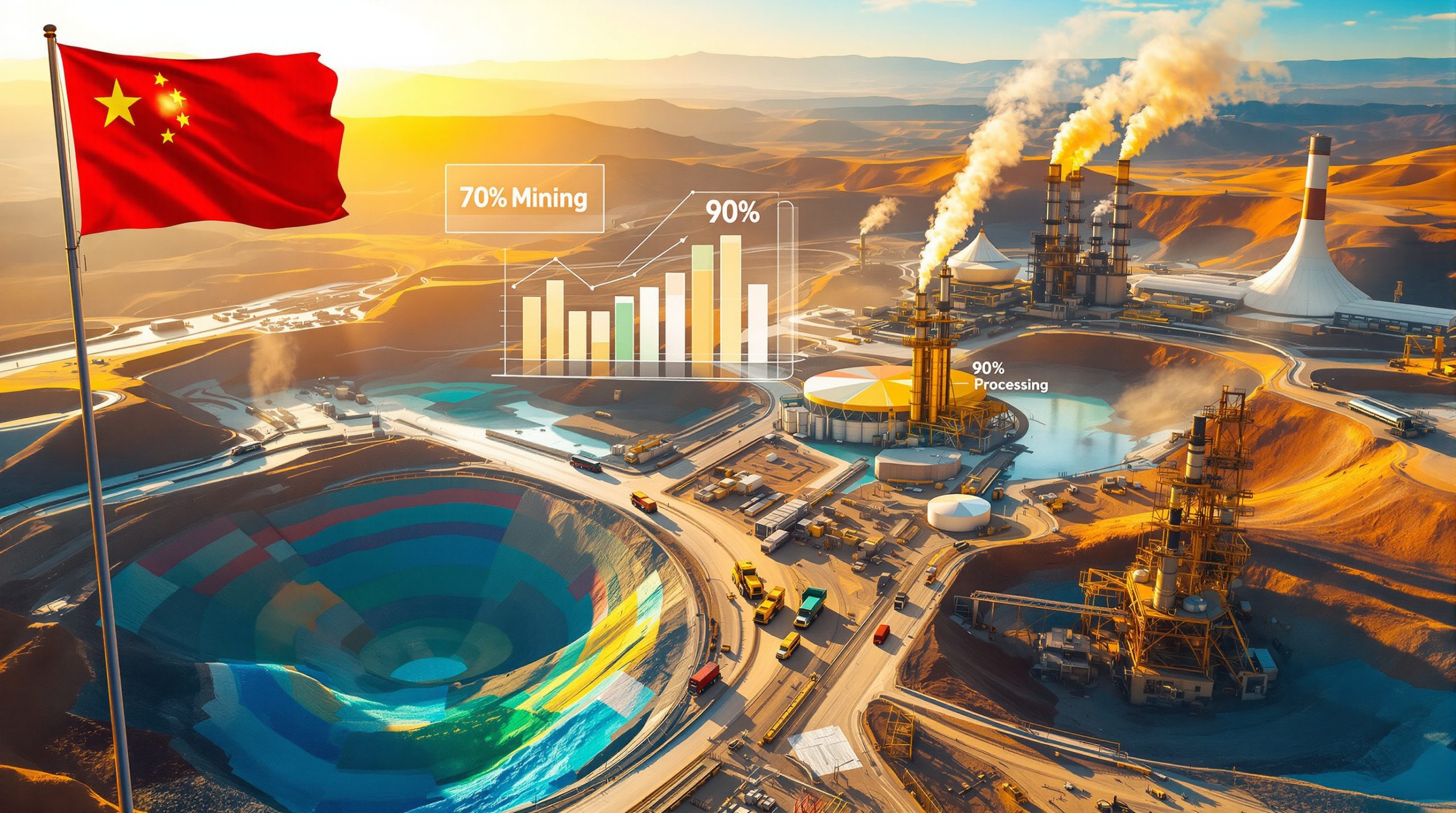Why Are Iron Ore Prices Rising When China Is Cutting Steel Production?
Iron ore prices have shown remarkable resilience in recent months, with futures climbing 1.6% in Singapore trading following a 2.1% weekly gain as of August 2025. This price strength—with futures trading at $103.60 per ton—comes despite announcements of production cuts in China's steel sector, creating what many market observers consider a paradoxical situation.
This counterintuitive market behavior has left many investors and industry watchers wondering: why would reducing steel production—the primary use for iron ore—actually boost demand for this key steelmaking ingredient?
The Surprising Market Response to Production Halt Announcements
The iron ore market trends have demonstrated unexpected buoyancy since early 2025, with prices edging higher despite various headwinds. The recent price movement reflects complex market dynamics that go beyond simple supply-demand equations.
Steel mills in Tangshan—China's primary steel manufacturing hub—recently received notifications to halt production beginning August 25, 2025. Yet rather than depressing iron ore prices as conventional wisdom might suggest, this news actually contributed to the price rally.
Yuan-denominated iron ore contracts on the Dalian Commodity Exchange also strengthened, while steel futures in Shanghai gained ground—reflecting a broader pattern of industrial commodity price increases despite production constraints.
What's Behind the Latest Production Halt Decision?
The Tangshan Shutdown Order
According to reporting from Mysteel on August 10, 2025, multiple steel producers in Tangshan have been ordered to temporarily cease operations. This shutdown directive targets one of China's most concentrated steel production zones, with the explicit purpose of improving air quality for a September 3 military parade scheduled in nearby Beijing.
These temporary environmental measures reflect a common pattern in Chinese industrial policy, where significant national events often trigger short-term production restrictions to ensure blue skies for high-profile occasions. The geographical proximity of Tangshan to Beijing makes its steel mills frequent targets for such measures.
Industry Impact: Tangshan represents approximately 14% of China's total crude steel output, making any production halt in this region significant for national supply levels.
How Temporary Shutdowns Affect Market Psychology
While production cuts logically suggest reduced demand for raw materials, the market often reacts in counterintuitive ways. Traders frequently position themselves ahead of announced restrictions, sometimes building inventory in anticipation of potential supply constraints.
The timing of these production halts—coming amid broader capacity reduction initiatives—has amplified their market impact. Rather than viewing production cuts as demand destruction, investors appear to be interpreting them as signs of market discipline that could support higher steel prices.
How Do Production Cuts Actually Boost Raw Material Prices?
The Steel Industry's Economic Paradox
The relationship between steel production cuts and iron ore prices reveals a fascinating economic paradox. When production limits are imposed, finished steel prices often rise faster than raw material costs fall, creating improved margins for producers despite reduced volume.
As Atilla Widnell, Managing Director of Navigate Commodities Ltd., explains: "Steel-production cuts have counter-intuitively been digested as a positive by onshore markets, given that increasing steel prices and margins are relieving pressure on a heavily suppressed cost base."
This margin expansion allows mills to maintain—or even increase—their purchasing power for iron ore, supporting prices despite lower physical consumption volumes. The industry's complex cost structure means that production discipline can actually boost input material values.
China's Broader Industrial Strategy
The "Anti-Involution" Campaign Explained
China's recent production cuts extend beyond temporary environmental measures, forming part of a broader strategic initiative dubbed the "anti-involution" campaign. This policy targets industrial overcapacity across multiple sectors, with steel production receiving particular attention due to its environmental footprint and chronic overcapacity issues.
Unlike previous short-term restrictions, this campaign represents a more fundamental shift in China's industrial philosophy—prioritizing quality over quantity in economic development. By reducing excess capacity, the policy aims to create a more balanced market where producers can maintain healthier margins.
The campaign has successfully boosted prices of various industrial products while improving profit margins at previously struggling steel mills. This improved profitability creates a financial cushion that allows producers to absorb higher raw material costs.
- Implementation focuses on older, less efficient production facilities
- Environmental compliance serves as a key mechanism for capacity reduction
- Regional production quotas are being more strictly enforced
- Higher-quality producers receive preferential treatment
What Role Does China's Property Sector Play in Iron Ore Demand?
Beijing's Recent Property Market Adjustments
A significant development supporting iron ore prices comes from China's property sector—traditionally the largest consumer of steel products. Authorities have recently removed certain restrictions on property purchases in Beijing, potentially improving housing demand in the capital.
This policy shift represents a targeted intervention in a crucial sector that has been under significant pressure. While limited to Beijing initially, market participants are watching closely for signs that similar measures might be implemented in other major cities.
The timing of these property market adjustments—coinciding with production restrictions—creates a complex market dynamic where reduced supply meets potentially improving demand surge insights.
The Troubled Property Sector's Influence on Commodities
China's property development industry has historically been a key source of demand for iron ore, with construction activities consuming approximately 25-30% of the country's steel output. Problems in the debt-ridden real estate sector have been weighing on commodity prices for several years.
The sector's challenges stem from several factors:
- Overleveraged developers facing debt repayment challenges
- Declining property sales in many regions
- Incomplete housing projects affecting consumer confidence
- Tighter financing conditions for development companies
Any signs of stabilization or recovery in this crucial sector have significant implications for steel consumption and, by extension, iron ore demand. The recent policy adjustments suggest authorities recognize the need to prevent further deterioration in this economically vital industry.
How Is the Broader Metals Market Performing?
Mixed Signals from Industrial Metals
While iron ore has demonstrated strength, performance across the wider metals complex shows more varied results. On the London Metal Exchange, industrial metal prices presented a mixed picture as of August 2025:
| Metal | Price Movement | Current Price |
|---|---|---|
| Copper | Down 0.4% | $9,723.50 per ton |
| Aluminum | Downward | Not specified |
| Nickel | Slight gain | Not specified |
This divergence in performance highlights how specific supply-demand dynamics and policy impacts affect each market types & deposits differently. Iron ore's relative outperformance suggests its unique position within China's industrial production ecosystem.
Global Supply Chain Considerations
Beyond China's domestic policies, iron ore prices remain influenced by global supply factors. Production from major exporters like Australia and Brazil, shipping costs, and logistics challenges all contribute to the market's overall balance.
Port inventory levels serve as a critical indicator of market tightness, with current stockpile trends showing gradual drawdowns at major Chinese ports. These inventory reductions support spot pricing even when headline demand appears constrained.
Quality differentials have also become increasingly important, with premium high-grade ores commanding stronger prices due to their environmental and productivity advantages—particularly relevant in a market focused on efficiency and emissions reduction.
What's the Outlook for Iron Ore Markets?
Short-Term Price Projections
The upcoming production halt period will likely create price volatility, with potential for further strengthening if steel prices continue to rise faster than raw material costs fall. Market participants should monitor several key factors:
- Actual implementation and enforcement of the announced restrictions
- Inventory levels at mills ahead of the production halt
- Steel price movements in response to reduced supply
- Property market transaction volumes following policy adjustments
- Port stockpile drawdown rates during restricted production
Seasonal demand patterns typically show strengthening in September-October as construction activity accelerates following summer slowdowns and ahead of winter restrictions. This seasonal factor could amplify the impact of production cuts.
Long-Term Market Fundamentals
Beyond immediate price movements, iron ore's longer-term outlook depends on several structural factors:
- China's Industrial Transformation: The ongoing shift toward higher-quality, lower-volume growth
- Environmental Policy Trajectory: Increasingly stringent emissions targets affecting production methods
- Alternative Steelmaking Technologies: Development of less iron-ore intensive processes
- Global Steel Consumption Patterns: Changing demand from automotive, construction, and infrastructure sectors
Disclaimer: Market projections involve uncertainty and multiple variables. Investors should conduct their own research and consider various price forecast insights when making investment decisions.
How Different Stakeholders Are Navigating the Market
Mining Companies' Strategic Responses
Major iron ore producers are adapting their strategies to navigate these market dynamics:
- Production Flexibility: Adjusting output to optimize for value rather than volume
- Quality Focus: Increasing investment in processing to enhance ore grades
- Cost Management: Implementing efficiency measures to maintain margins
- Capital Allocation: Balancing shareholder returns with growth investments
- Contract Structures: Exploring more flexible pricing mechanisms
The largest producers with high-grade deposits are generally better positioned to benefit from China's quality-focused policies, while higher-cost operators face margin pressures despite elevated price levels.
Steel Producers' Adaptation Strategies
China's steel industry participants are implementing various approaches to adapt to the changing regulatory and market environment:
- Upgrading facilities to improve environmental compliance
- Shifting product mix toward higher-value steel varieties
- Consolidating operations to achieve scale efficiencies
- Investing in technologies that reduce emissions and energy consumption
- Diversifying customer bases beyond property construction
Mills located in environmentally sensitive regions face greater adaptation challenges, while those with newer facilities and better environmental credentials may benefit from competitors' production constraints.
FAQ: Understanding Iron Ore Market Dynamics
Why would reducing steel production increase demand for iron ore?
When steel production cuts are implemented, they often create market discipline that drives up finished steel prices more than they reduce physical consumption. This improves steel mill profitability, allowing producers to pay more for iron ore while maintaining healthy margins. Additionally, production cuts signal industry discipline, which can improve investor sentiment toward both steel and iron ore markets.
How significant is China's property sector to iron ore demand?
The property sector traditionally accounts for approximately 25-30% of China's steel consumption, making it a critical driver of iron ore imports and pricing. Construction activities—including residential buildings, commercial properties, and related infrastructure—represent the largest end-use category for steel products in China. Any policy changes affecting real estate development have substantial ripple effects throughout the steel value chain.
What exactly is China's "anti-involution" campaign?
China's "anti-involution" campaign represents a strategic policy shift away from pursuing growth primarily through capacity expansion and toward improving efficiency, environmental performance, and economic returns. In the steel sector, this means eliminating outdated, polluting, and inefficient production capacity while encouraging consolidation and technological upgrading. The term "involution" refers to the diminishing returns from continually expanding production without corresponding efficiency improvements.
How do temporary production halts affect long-term market trends?
While short-term restrictions create immediate price volatility, their cumulative effect shapes industry expectations, investment decisions, and capacity planning over longer timeframes. Repeated implementation of temporary measures signals regulatory priorities, encouraging preemptive adaptation by industry participants. Over time, these temporary measures often evolve into more permanent structural changes as producers adjust their business models and investment decisions to align with policy direction.
Further Exploration:
Readers interested in learning more about iron ore market dynamics can also explore related educational content from MINING.com, which regularly covers developments in global commodity markets and China's industrial policies.
Ready to Stay Ahead of the Next Major Mineral Discovery?
Discover how significant mineral discoveries can lead to substantial market returns by exploring Discovery Alert's dedicated discoveries page, where our proprietary Discovery IQ model instantly alerts investors to significant ASX mineral discoveries, turning complex market data into actionable investment insights. Begin your 30-day free trial today at Discovery Alert.




